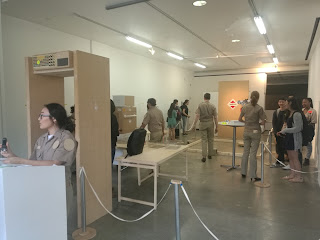Last week I attended the Leonardo Art Science Evening Rendezvous. Several speakers presented their own work on the combination of art and science. Among them, the one that interests me the most is artist Behnaz Farahi.
Farahi’s artworks can be categorized into two major categories. Some of her works, including The Living, Breathing Wall (2013), The Breathing Wall II (2014) and Aurora (2016), explore the interactive relationships between human and the surrounding environment; other works, such as Synapse (2015), Ruff (2015)and Caress of the Gaze (2015), have focuses on the wearable devices as extensions of the human body.

The Living, Breathing Wall (2013) is an installation of a wall that could move with respond to human action and human language. It is clear, both from the title of the artwork and from the installation itself, that the artist aims to create a parallelism between the organic human body and the surrounding environment. The surface of the wall is made of Spandex, which corresponds to the skin of human. Supporting devices include aluminum strands and shape memory alloy springs, which act like bones and muscles, respectively. The control system behind the wall is a combination of Microsoft’s Kinect, which receives information from human visitors interacting with the wall and therefore can be regarded as the eyes and ears of the wall, and an Arduino microcontroller which acts like the brain of the entire system.
What I feel the artist is trying to convey through the installation is a view of anti-anthropocentricism. The artist has shown that it is possible to build up a system with non-living material that imitates the actions and responses an living organism has. In such a sense we are not different from machines we built and environment we created. Such a view is further enhanced by her other works on the wearable devices, for example, Synapse (2015).
Synapse (2015) is a 3D-printed helmet that could trace the wearer’s brain activity and change shapes correspondingly. With the help of electroencephalography(also known as EEG, a method that enables the tracing of brain activity), the project gives a viable option for human to control the environment directly through our thoughts. The artwork further investigates into the combination of human and machines, and has shown future possibilities of breaking the boundaries of a living thing and a non-living environment.
From Behnaz Farahi’s artworks, I have learned a new feature artworks can provide: artists can act as pioneers in future advancements of technology through the combination of their creative design and modern technology.
Proof of Attendance
Sources:
Behnaz Farahi's Personal Website, <http://www.behnazfarahi.com/>




Comments
Post a Comment